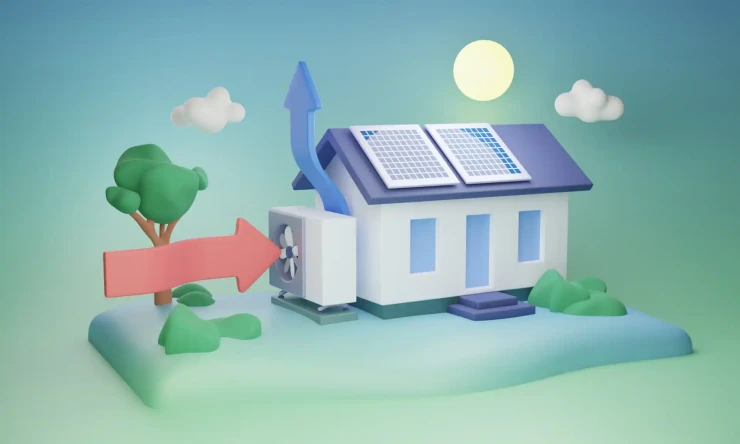If you choose to install an air source heat pump you are opting for a low carbon heating system which is becoming increasingly popular in the UK. Being more energy efficient they can reduce your carbon emissions and help the UK meet its net zero target by 2050. You will also be future proofing your home as gas boilers will be banned in the future starting with new builds in 2025.
Currently 85% of UK households are still heated by gas central heating meaning 13 to 14% of the UK’s total carbon emissions come from keeping ourselves warm. We still have a long way to go before we can bring this percentage down!
Although installing an air source heat pump (ASHP) isn’t as complex and disruptive as some alternatives such as a ground source heat pump (GSHP) it’s still important to find a professional specialist to do the work.
How to find the right air source heat pump installer
An air source heat pump (ASHP) should be installed by an accredited Microgeneration Certification scheme (MCS) installer because they will have completed installer training and also have to comply with certain codes of conduct and industry compliance in order to certify the installation. Choosing the right heat pump installer is extremely important as they will be with you for the lifespan of your heat pump. You should check that your installer is not only certified but also has a record of good customer service post installation.
It is recommended that you compare different installers and their offers before you choose the one that is right for you. You can also check the MCS website for registered installers in your area or get a referral from a manufacturer for approved or accredited installers in your area. In order to ensure full continuity from specification right through to commissioning it is advisable to get a supply and install contract. It is possible to purchase the system components separately, but you would need to be sure that they are all compatible with each other.
COMPARE PRICES FROM LOCAL INSTALLERS
Compare prices from local companies fast & free
Enter your postcode to compare quotes from leading professionals. We promise to keep your information Safe & Secure. Privacy Policy
How long does it take to install an air source heat pump?
Usually, any preparation work such as building a solid base for the outdoor unit to stand on would need to be completed before the installation date.
Most heat pumps do not require planning permission but it’s best to get this checked before installing it in your home.
Depending on the complexity of the works, an air source heat pump (ASHP) can be installed in 2-5 days. You shouldn’t be disturbed for long as part of the work is done outside though you should be aware that you might be without hot water for 1-2 days.
Your installer should be able to give you a good idea of how long it will take after they’ve done the initial assessment.
How Much Does An Air Source Heat Pump Installation Cost?
The cost of installing an air source heat pump typically costs between £8,000 and £14,000. The cost depends on a number of factors such as the size of the ASHP you need (the more powerful, the more expensive), the model of ASHP you choose, how well insulated your home is and how complex the installation will be (you might need underfloor heating or new radiators, for example). Always get more than one quote from reputable installers.
What Funding Options Are Available in the UK?
The government is offering grants to encourage homeowners to install low carbon heating systems like air source heat pumps through the Boiler Upgrade Scheme. These grants will help homeowners with the upfront cost of low carbon heating technologies. Most households in England and Wales that join the scheme will receive a £5,000 grant to help cover the cost and installation of an air source heat pump.
Low carbon systems that are installed on or after 1 April 2022 will be entitled to this support, providing they meet the eligibility criteria. The scheme will run until 2025.
To be eligible for the grant, a valid, Energy Performance Certificate (EPC) from the last 10 years, with no recommendations for cavity wall or loft insulation is required.
Here’s a guide to explain the basic process of installing an air source heat pump (ASHP). We will look at the various steps before, during and after the installation process.
The process of installing an air source heat pump will differ slightly depending on whether it’s a retrofit or a new build. However, there are 3 main steps in the whole process:
- Pre-Installation - onsite survey and assessing suitability
- Installation - installation of indoor and outdoor units, and connecting them
- Post Installation - finishing and maintenance
Pre-Installation
Before any installation, the installer you have chosen will conduct a thorough inspection of your home. This is to ensure they recommend the right ASHP for your property. Heat loss calculations will be made to determine the size of the heat pump that your home needs. The type and size of the heat pump they recommend will depend on the size of your home, how well your home is insulated and your heating needs. If your home isn’t well insulated your heat pump will have to work harder and won’t work as efficiently so could end up costing you more to run. You may need to invest in loft and cavity wall insulation and double or triple glazing before installing an air source heat pump.
Your installer will design and specify the equipment including the heating capacity, location of equipment, distribution networks and the user interfaces such as room thermostats.
Your installer will give you a written report of their recommendations with sketches of the property for efficiency installation of the system once they have completed their assessment.
As part of the report its mandatory for them to give you an estimate of how much it will cost to run your heat pump.
Now is the time to ask them any questions you may have about the installation process and whether you need to prepare anything inside or outside of your house before they begin work.
Heat pump installers are also qualified to remove any existing heating systems you night have such as a gas boiler.
Installing and Connecting the Indoor and Outdoor Units
The ASHP itself needs to be installed outside on a flat concrete base. The unit will be bolted to the ground and the installer will secure it with brackets. Ideally, it’s best to locate the heat pump at ground level with easy access for maintenance but a flat roof is an option if this is not possible. There is no need for any digging like there would be with a ground source heat pump. This unit is often around 1200mm tall, 1000mm wide and around 400mm deep and is the one you would typically see outside a house. This unit sources air from outside and compresses it into warm air. Your installer will choose an area for the unit not too close to your neighbours where there is ample airflow with minimal obstructions. As per Planning Permission regulations, air source heat pumps need to be installed at least one metre from the property boundary. For those air source heat pumps installed on a flat roof, they also need to one metre from the edge.
The installer will connect the return and flow heating pipes and electrical power cables outside your home.
At this point the indoor units are installed and connected to radiators or underfloor heating and hot water pipes. Most heat pumps will be connected to at least one hot water cylinder which is around 600mm wide by around 1600mm tall. Sometimes there can be a further cylinder (buffer tank or low loss header) around a third of the size of the hot water cylinder. There will also be an ASHP control box indoors which is around 400mm x 400mm x 100mm deep. On top of that there will be a number of circulation pumps and pipework, as well as a manifold and control box for any underfloor heating.
More often than not your radiators will have to be replaced for bigger ones, either double or triple sized. If this is the case the installer will replace your radiators and connect your new ASHP. Or, if you’re using an underfloor heating system, the installer will need to either set that up or connect the ASHP to your existing system. The indoor cylinder and the outdoor unit will be wired and connected. The indoor unit will be connected to the radiators and other units where heat is released from within the house. Depending on your home and the distance between the indoor and outside units, wiring will need to be made by normally drilling a hole in a wall. Your installer will then connect them through refrigerant lines and electrical wires. Finally, all the controls and thermostats need to be installed inside your house. Your installer should tidy up after he’s finished the installation and explain to you how the system works. They’ll also start the system up to make sure it’s working to the manufacturer’s standards. They may also offer a maintenance package and aftercare service.
Post-Installation
When the installation has been completed there will be some finishing fixes to be made to ensure the efficient working of the heat pump system. Most air source heat pumps come with sensors so these will need to be installed so that the heat pump can send temperature signals to your thermostat.
This is a good time to talk to your installer about the maintenance requirements. Even though ASHPs have low maintenance requirements its advisable to keep checking the filters and cleaning the fans from time to time. Your installer can do this for you to ensure that the heat pump runs efficiently throughout its long lifespan of sometimes more than 20 years.





























